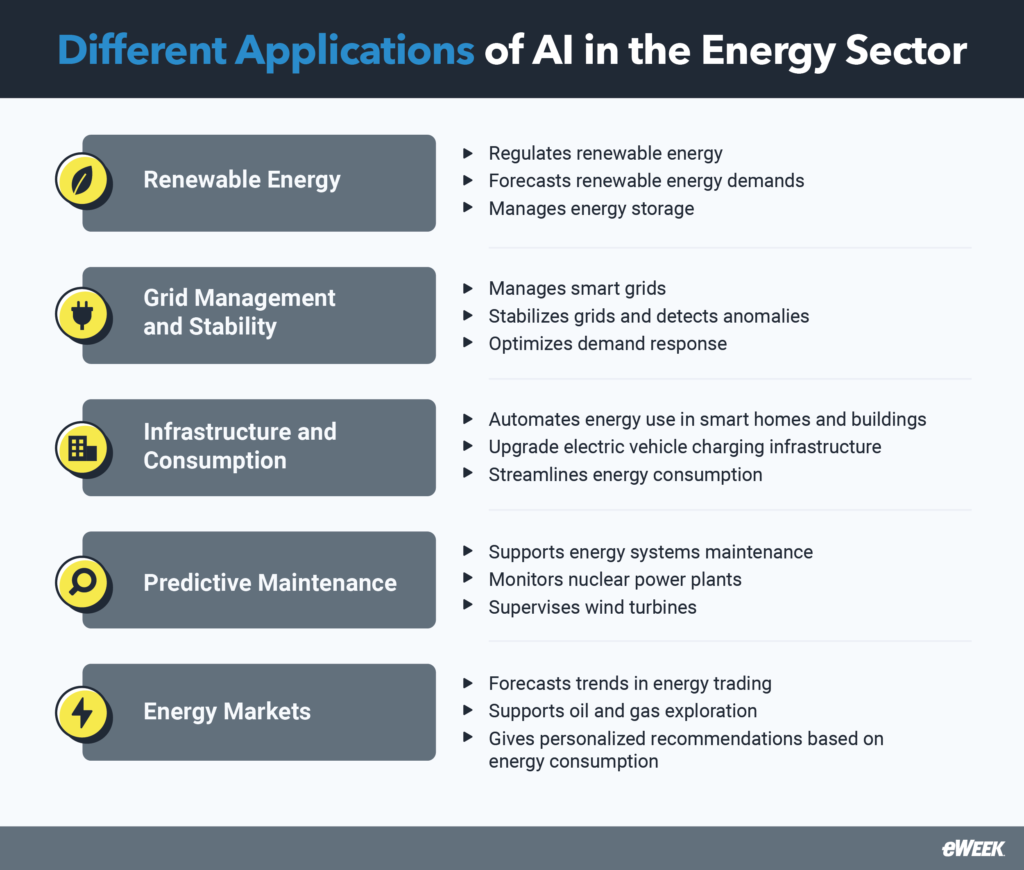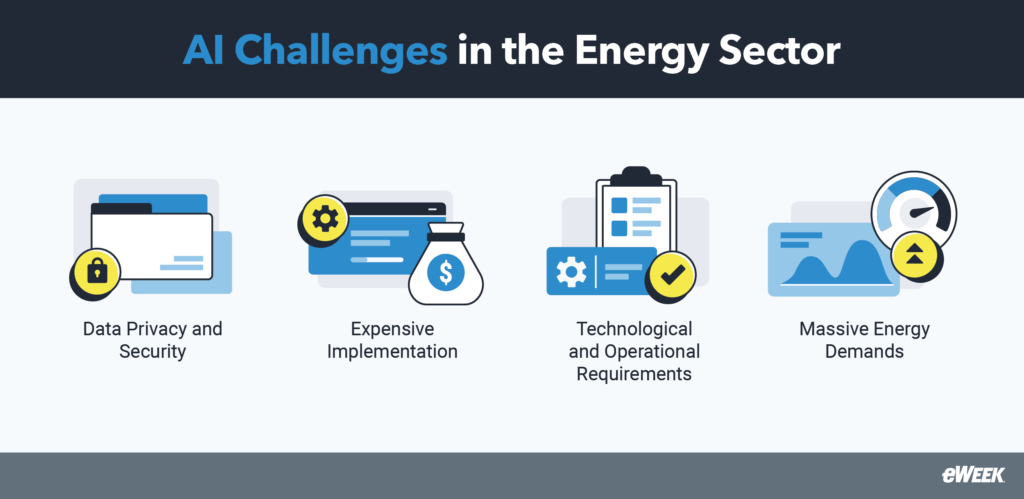Artificial intelligence (AI) is modernizing how energy is produced, distributed, and used, changing the game in the energy sector. The advanced technology not only streamlines operations and reduces costs, but also reinforces the reliability of energy systems today. However, despite its numerous advantages, AI energy also faces serious challenges that need to be addressed—concerns related to the technology’s energy consumption, for example.
As the world transitions from fossil fuels to sustainable alternatives, understanding AI capabilities in analyzing extensive datasets from power grids and generating real-time predictions to optimize energy generation is paramount for anticipating fluctuations in energy supply and demand. This understanding allows for better usage of renewable energy sources, prompting a more stable and environmentally-friendly energy future.
KEY TAKEAWAYS
- •Using AI in the energy industry offers several benefits, including increased efficiency and reduced costs, enhanced energy conservation, data-driven decision-making, and more reliable safety and security measures. (Jump to Section)
- •Challenges of using AI in the energy sector include data privacy and security, expensive implementation, technological and operational requirements, and significant energy demands. (Jump to Section)
- •GE Vernova, Constellation, and Siemens Energy are some of the companies leading the way in incorporating AI in energy-related processes and predictive maintenance, showcasing how AI can reshape the energy sector. (Jump to Section)
Featured Partners: AI Software
TABLE OF CONTENTS
What is AI Energy?
“AI “energy refers to the application of artificial intelligence technologies in the energy sector to increase the efficiency and effectiveness of energy production, distribution, and consumption. This groundbreaking advancement uses advanced computational techniques to analyze vast datasets from interconnected power grids. By honing operational reliability, AI energy plays an important part in forecasting electricity demand and supply, integrating renewable energy sources, and automating decision-making processes. AI is redefining how the energy industry addresses key challenges and elevates overall performance.
Five Applications of AI in Energy
AI is making advancements in the energy sector by systematizing energy management and supporting sustainable practices across various domains.

AI in Renewable Energy
AI optimizes various processes, including energy production, storage, and forecasting. It plays a significant role in enhancing the reliability, scalability, and management of renewable energy systems in the following ways:
- Renewable Energy Management: AI algorithms adjust the operation of renewable systems, like wind turbines and solar panels, improving energy production to match real-time consumption and grid requirements.
- Renewable Energy Forecasting: By analyzing historical data, weather patterns, and consumption trends, AI models predict energy demand. This results in a more balanced energy distribution.
- Energy Storage Management: Advanced machine learning techniques help manage energy storage, refining charging and discharging cycles to maximize power. They also stabilize the grid in fluctuating renewable environments.
AI in Grid Management and Stability
Handling grid infrastructure is becoming more sophisticated with AI integration, increasing stability and accelerating response times. Some of the most common uses include the following:
- Smart Grid Management: Cloud-connected AI systems facilitate the better management of power generation and distribution for smart grids. These systems anticipate high-demand periods and reroute energy effectively to maintain grid performance.
- Grid Stability and Anomaly Detection: With AI’s automated monitoring, organizations can continuously assess the grid’s health. It aids in predicting potential faults and responding to disturbances before they escalate to larger issues.
- Demand Response Optimization: By analyzing consumption data, AI tools intelligently regulate energy loads during peak periods. This reduces the strain on the grid and prevents blackouts while enhancing operations.
AI in Infrastructure and Consumption
AI is changing how energy is consumed and managed across homes, buildings, and transportation systems. Widely used applications include the following:
- Smart Homes and Buildings: AI-powered systems in smart homes and buildings automate energy use. These tools modify lighting, heating, and cooling based on real-time information to prioritize comfort and reduce consumption.
- Electric Vehicle Charging Infrastructure: AI technologies upgrade EV charging infrastructure by adjusting charging schedules. This balances load distribution to prevent strain on the grid and minimizes environmental impact. Plus, AI apps enable positive user experience by offering updates on station availability, wait times, and charging costs.
- Energy Consumption Optimization: Data-driven algorithms track energy use in buildings, uncovering inefficiencies. Additionally, AI solutions make automatic fixes to reduce waste, ultimately improving sustainability and lowering costs.
AI in Predictive Maintenance
In energy systems, AI refines maintenance protocols, extending equipment lifespan and decreasing unexpected failures. It’s commonly used in the following applications:
- Energy Systems Maintenance: Predictive models forecast device damages by analyzing usage patterns, weather data, and operational stats. This empowers organizations to perform timely intervention before costly breakdowns occur.
- Nuclear Power Plant Monitoring: Ongoing AI-driven monitoring of nuclear facilities detects abnormalities early. As a result, energy companies can prevent radiation exposure risks and system malfunctions.
- Wind Turbine Supervision: AI evaluates data from sensors installed on turbine components, such as blades and generators. These sensors constantly track vibration, temperature, and operational performance to detect early signs of wear and possible failures. This allows operators to schedule maintenance before serious issues arise and minimizes downtime.
AI in Energy Markets
AI molds how energy markets operate, advances oil and gas explorations, and delivers valuable insights to both businesses and consumers. By elevating operational processes, it enables better service quality across the board. The most common energy uses include the following:
- Energy Trading: AI models can analyze market variables like demand, supply, and weather conditions to forecast trends and change trading strategies accordingly. In addition, with historical data analysis, AI can pinpoint competitors’ recurring behavioral patterns.
- Oil and Gas Exploration: AI supports exploration by assessing geological data, revamping drilling strategies, and accurately measuring reservoir potential. AI models help identify optimal well placements and predict production outcomes. They promote streamlined resource extraction, expanding the profitability of oil and gas operations.
- Generative AI for Energy Recommendations: Based on past customer consumption data, market prices, and energy availability, generative AI can give personalized recommendations on energy use, pricing plans, and savings strategies. This strengthens customer engagements for organizations.
Benefits of AI in the Energy Industry
Adopting AI in the energy industry is changing energy generation, management, and consumption, introducing a range of important benefits. These advancements drive innovation and support global sustainability goals, preparing the energy sector for a cleaner, more resilient future.

Increased Efficiency and Reduced Costs
AI dramatically boosts efficiency by automating complex processes and analyzing extensive datasets from energy systems. AI optimizes energy generation by accurately predicting demand and adjusting production schedules. This alignment reduces energy waste and lowers costs, so power plants can match output with consumption patterns. Additionally, AI-driven predictive maintenance minimizes equipment downtime and cuts maintenance expenses, resulting in substantial savings.
Enhanced Energy Conservation
AI identifies process inefficiencies and recommends strategy revisions through the examination of energy consumption patterns. Smart grids, for example, dynamically regulate energy flows, enabling smooth energy distribution and keeping down unnecessary use. AI technologies also balance variable outputs from wind and solar power with the demands of the grid, minimizing energy waste.
Improved Decision-Making
The large amounts of data generated by energy systems can overwhelm human operators, making it difficult to extract meaningful insights. But with advanced analytics and machine learning algorithms, AI empowers energy businesses to understand this data effectively, providing actionable insights. Aside from stabilizing energy generation and distribution, this raises grid reliability by detecting anomalies and predicting failures. With more accurate forecasting, decision-makers can manage energy sources effectively and achieve environmental objectives.
Bolstered Safety and Security
Applying AI bolsters safety and security measures, offering robust protections against both operational hazards and cyber threats. AI scans patterns and behaviors within energy systems and flags irregularities that may signal cyberattacks. This allows cybersecurity teams to quickly intervene and fortify system defenses. In addition, AI ensures workplace safety by keeping an eye on environmental conditions and operational processes. Organizations can trust that protocols are being followed and machineries are functioning properly. Energy companies can reduce the risks of accidents and protect employees from dangerous situations.
Challenges and Limitations of AI in Energy
While AI has immense potential to revamp the energy sector, it also encounters numerous challenges and limitations that must be addressed. Overcoming these hurdles is necessary in making the most of AI capabilities and preserving the stability and security of the future of energy.

Data Privacy and Security Concerns
Organizations in the energy industry produce and process large amounts of sensitive data, from consumer usage patterns to grid operations. As AI solutions rely heavily on this data for training models and making predictions, the risk of data breaches and cybersecurity threats arises. Protecting this data and maintaining privacy compliance remains a major concern, especially today when regulations constantly change and cyberattacks become more sophisticated.
High Implementation Costs
Integrating AI into existing energy infrastructure is expensive. Purchasing new hardware, upgrading software, and training personnel, can be costly and prohibitive for some organizations. In addition, training AI models require substantial computational power—particularly for generative AI technologies, which consume considerably more electricity than traditional systems. As AI becomes more advanced, the need for more data centers will rise, further driving up operational costs.
Technological and Operational Challenges
Deploying AI in energy sectors comes with a mix of technological and operational challenges. For starters, many legacy systems were built long before AI became popular and are not designed for the technology, resulting in compatibility issues and slowing down implementation. Renewable energy sources, like solar and wind can be unpredictable, and AI needs to be flexible enough to handle these fluctuations while keeping the grid stable. Finally, scaling AI solutions on extensive networks demands large-scale resources, making deployment even more difficult.
Significant Energy Demands
While AI can greatly refine energy systems, there are valid concerns about significant energy demands that are associated with its implementation. Since powerful AI models need more power, it can put a strain on our already overloaded electrical grids. The ongoing evolution of AI technologies raises issues about their energy consumption actually conflicting with the industry’s goals of decreasing carbon emissions and promoting sustainability.
3 Advanced AI Energy Companies to Watch
Several renowned names are setting the pace for AI-driven intonation in the energy sector, each implementing this advanced technology to tackle key challenges. From boosting operational efficiency to safeguarding a sustainable future, these AI companies showcase how AI is changing the way energy is managed.
GE Vernova
General Electronic (GE) Vernova is leading the way in AI energy with its broad spectrum of solutions, including renewable energy, power generation, and digital technologies. GE Vernova relies on AI to regulate energy production and secure grid stability. One of its notable AI applications is in its Asset Performance Management (APM) software, which automates monitoring and inspection of energy assets. Its autonomous inspection tool turns visual data into actionable insights and brings down safety hazards, such as workers performing dangerous inspections at elevated heights. With a strong emphasis on decarbonization, this company aims to provide responsible and affordable energy solutions while targeting carbon neutrality by 2030. GE’s integration of AI across its diverse portfolio makes it a key player in the ongoing shift to cleaner energy.

Constellation
Constellation, or Constellation Energy, is one of the largest producers of carbon-free energy companies in the U.S. The enterprise actively employs AI in its operations, specifically within its nuclear reactor fleet. Through its collaboration with Blue Wave AI Labs, Constellation uses machine learning tools to monitor reactor sensores and detect when they drift out of calibration—preventing unexpected shutdowns and promoting safety. These tools also aid in optimizing fuel consumption, minimizing waste, and lowering costs across the company’s reactors. Constellation has recently secured a 20-year power purchase agreement with Microsoft. This deal will supply Microsoft with 835 megawatts of carbon-free electricity for its AI data centers. The partnership underscores the organization’s commitment to contributing to decarbonization efforts by using nuclear power as a reliable, carbon-free energy source to support technological advancements.

Siemens Energy
Siemens Energy, another frontrunner in the energy sector, is using AI extensively in its operations, particularly in enhancing grid management, energy production, and system performance. Its DynaGridCenter in Germany employs real-time data analytics to handle complex energy flows from renewable sources, such as wind and solar. Siemens Energy focuses on digital twin technologies to simulate the performance of energy assets, making sure that they operate at peak conditions while reducing downtime. Additionally, it developed Power Intelligence energy management tools, which combine load shedding for blackout prevention and power generation handling for stabilized energy use.

3 AI Energy Courses to Learn More
These online AI energy courses explore how AI modifies our approach to energy and handles climate change concerns. They elaborate on how AI can support renewable energy, simplify grid operations, and combat environmental issues, and give learners the tools they need to deal with modern energy problems and see how technology can strengthen green initiatives.
AI and Climate Change on Coursera

The AI and Climate Change course on Coursera is part of the AI for Good Specialization by DeepLearning.AI. It delivers a comprehensive introduction to the application of AI in tackling climate change challenges, including its role in the energy sector. Spanning four modules, this curriculum discusses mechanisms behind climate change, biodiversity monitoring, and modeling of renewable energy sources, like wind power, using AI techniques. It dives into how AI can regulate energy consumption patterns and advance grid management. It includes videos, readings, and quizzes, with a total estimated completion time of 14 hours. A monthly subscription of $59 to Coursera Plus is necessary to enroll. Made for beginners, this course requires no prior experience in AI.
Transforming the Grid: AI, Renewables, Storage, EVs, and Prosumers on Stanford Online

The Transforming the Grid: AI, Renewables, Storage, EVs, and Prosumers course offered by Stanford University provides an in-depth exploration of electric grid technologies, emphasizing the integration of AI and machine learning. It covers fundamental topics, such as the role of AI in managing renewable energy sources, energy storage systems, and energy vehicles. It also teaches how to calculate pricing and rate models for storage and renewable scenarios. This online course spans six hours and gives learners 60 days to complete the material at their own pace. The course is priced at $395, and is part of Stanford Online’s one-year subscription plan of $1,975. This course is for all levels of professionals, no engineering or energy background needed.
Intelligent and Integrated Energy Systems on edX

The DelftX Intelligent and Integrated Energy Systems on edX equips learners with the skills to update energy systems using digitalization and AI. The program focuses on evaluating how AI and machine learning elevate grid flexibility and energy management, as well as reduce carbon footprints through electric mobility and electrified heating. It consists of four skill-building courses which can be completed in about six months, and has graded assignments and exams. While there were no specific prerequisites on the site, a basic understanding of energy systems may be beneficial. The cost of the entire certificate program is $596.
Frequently Asked Questions (FAQs)
AI has a mixed impact on the climate. On one hand, training large AI models calls for substantial energy, as the data centers powering these systems consume large amounts of energy. According to World Economic Forum, training generative AI models like GPT-3 consumed approximately the same amount of energy as 130 American households over the course of one year. This can contribute to carbon emissions, especially if the energy comes from non-renewable sources. However, AI can also be good in combating climate change—it can optimize energy use, integrate renewable sources, and decrease waste across various sectors.
AI photosynthesis is a process that mimics the natural process by which plants convert sunlight, water, and carbon dioxide into energy. This aims to produce renewable fuels directly from sunlight, offering a potentially reliable alternative to conventional solar energy methods. Key techniques include splitting water to generate hydrogen and converting carbon dioxide into usable fuels. Although still largely experimental, AI photosynthesis holds promise for giving sustainable energy solutions in the future.
Conclusion: The Role of AI in Shaping the Future of Energy
AI continues to evolve, and its capacity to drive efficiency and sustainability is becoming undeniable. With that said, it is imperative to carefully consider the challenges AI adoption in the energy industry presents, particularly in energy consumption. Balancing innovation and responsibility is a must as more companies start to rely on AI. The ongoing developments in AI energy will have a huge impact on operational practices and resource management of both AI startups and global enterprises alike, shaping the industry’s future direction.
Read our article on 10 AI trends to stay ahead of the curve and gain insights into the emerging AI developments.
